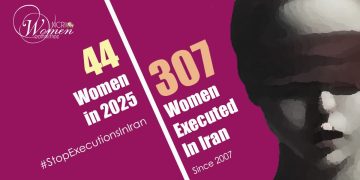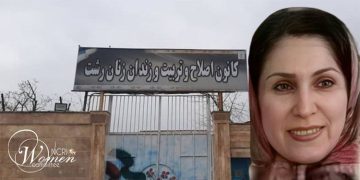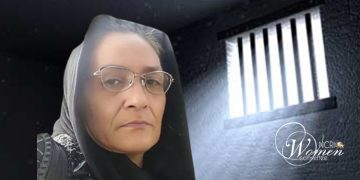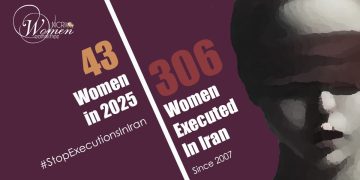Death penalty for women under the misogynous rule of the mullahs in Iran.
The World Day Against the Death Penalty this year is dedicated to women “who risk being sentenced to death, who have received a death sentence, who have been executed, and to those who have had their death sentences commuted, exonerated, or pardoned.”
In 2002, the World Coalition Against the Death Penalty Organization and Amnesty International declared October 10 as World Day against the Death Penalty. It is a day to remind ourselves of the excruciating pain of those condemned and awaiting their death.
The World Coalition Against the Death Penalty Organization said, “while working towards the complete abolition of the death penalty worldwide for all crimes and for all genders, it is crucial to sound the alarm on the discrimination women face and the consequences such discrimination can have on a death sentence.”
Focused on the violations of women’s rights in Iran and the struggle of Iranian women for freedom and equality, the NCRI Women’s Committee has been marking October 10 every year to remind the world that the clerical regime in Iran is the world’s chief executioner of women. The regime frequently hands down the death penalty for women.
The international law recommends alternative punishments for the imprisonment of mothers who must take care of their children. In Iran, however, the regime imprisons mothers and hands down death sentences for them.

The death penalty, the Iranian regime’s means of survival
Iran holds the world record for the execution of women and the per capita execution rate among all countries.
The death penalty is the clerical regime’s means for existence and survival. The Iranian regime uses the death penalty as a tool to suppress and silence a disgruntled public, the majority of whom live under the poverty line, are unemployed, and deprived of freedom of expression.
This punishment, synonymous with the legal killing of human beings by governments, is both a violation of the “right to life” represented by the Third Principle of the Universal Declaration of Human Rights and a violation of the Fifth Principle, which states, “No one shall be subjected to torture or to cruel, inhuman or degrading treatment or punishment.”
The clerical regime has executed at least 4,600 persons under the so-called “moderate” Hassan Rouhani and to date under the henchman of the 1988 massacre, Ebrahim Raisi, as president. One hundred and twenty-one (121) of those executed have been women, an average of 15 ordinary women executed every year.
Issuing the death penalty for women and others, and carrying them out despite international outcries, enable the clerical regime to keep up an atmosphere of fear among the public, a feeling that no one can help them if they do not comply. The regime executed Reyhaneh Jabbari, Zeinab Sekaanvand, Mostafa Salehi, Navid Afkari, and numerous juvenile offenders despite international appeals by Amnesty International, various governments, and human rights advocates.
The Iranian regime also incarcerates anyone who opposes the death penalty, among them Atena Daemi and Golrokh Iraee.
The United Nations released a World Report on the Situation of Human Rights Defenders in December 2018 by Mr. Michel Forst, UN Special Rapporteur on Human Rights Defenders. The report emphasized that “[The Iranian regime] has also intensified its crackdown on women… Scores of women defenders are persecuted for their legitimate work… Atena Daemi and Golrokh Ebrahimi Iraee are detained for fighting for women’s rights, opposing child labour, and opposing the death penalty… The State views human rights defenders as threats to national security.”
Amnesty International issued a statement on September 3, 2018, warning that such arrests “are a blatant attempt to silence those advocating for human rights in Iran.”
After protesting the execution of three Kurdish political prisoners in September 2018, the Iranian Ministry of Intelligence filed a suit against political prisoners Maryam Akbari Monfared, Golrokh Ebrahimi Iraee, and Atena Daemi, for which they received additional sentences.

Who are the women who receive the death penalty?
The clerical judiciary usually hands down the death penalty for women who commit murder.
Female convicts usually commit murder in self-defense against domestic violence, which is widespread in Iran. In the face of widespread poverty and parents who force their daughters into early marriages, some women who are also deprived of the right to divorce end up committing murder while others commit suicide.
Many of these women commit murder at a young age as a minor and as a victim of forced early marriages and domestic violence. They go through unfair trials without having access to a lawyer.
The Central Prison of Urmia authorities hanged Zeinab Sekaanvand, 24, on October 2, 2018. She had been coerced into confessing to the murder of her husband in 2012 at the age of 17. She was a victim of domestic violence, but her claims were not adequately examined during her trial.
Forced into marriage at the age of 15, Zeinab Sekaanvand lived two painful years, being battered every day by her husband. She told the judge that her husband’s brother, who had raped her several times, had committed the murder.
Another infamous example of the death penalty for women was the case of Reyhaneh Jabbari. Reyhaneh was an interior designer, 19 years old when she was assaulted by one of her clients, a senior official of the Intelligence Ministry. Reyhaneh killed the man in self-defense; however, the court convicted and executed her after seven years of torture and imprisonment on October 25, 2014. The Intelligence Ministry and prison officials wanted Reyhaneh to make false confessions to justify their official’s crime in exchange for her life.
In a similar case, Zahra Esma’ili, 42, with two children, was executed on February 17, 2021, for having claimed responsibility for the murder of her husband. She did so to save her teenage daughter, who had shot her father in the head.
Zahra’s husband was one of the director generals of the mullahs’ Ministry of Intelligence. He routinely mistreated and battered his wife and children. He used to take different women home before the eyes of his own family. He had even threatened to kill his wife and attempted to assault his teenage daughter sexually. Because of such brutalities, his daughter killed him with the help of her brother.
Many women linger in Qarchak Prison and other prisons on death row.
Political prisoner Golrokh Ebrahimi Iraee in a letter from prison, wrote, “I learned that a large percentage of them had murdered their husbands —instantly or on a pre-meditated plan—after years of being humiliated, insulted, battered and even tortured by them and because of being deprived of their right to divorce. Although, they consider themselves criminals but are convinced that if any of their repeated appeals for divorce had been granted, they would not have committed such a crime.”
Executions of thousands of women on political grounds
The Iranian regime is among those governments that execute their opponents. At least 120,000 people, including thousands of women, have been executed in Iran since 1981 for their opposition to the government.
International laws prohibit the execution of pregnant women. However, in Iran, the regime executed at least 50 pregnant women in the 1980s.
They also executed and hanged thousands of women in 1988, during the massacre of 30,000 political prisoners in Iran.
The clerical regime’s incumbent president, Ebrahim Raisi, was a member of the Death Commission in Tehran, ordering the executions of political prisoners for adhering to their political positions in opposition to the regime. Ninety percent of those executed were members of the main Iranian opposition, the People’s Mojahedin Organization of Iran (PMOI/MEK).
Ebrahim Raisi is a mass murderer known among the public as the henchman of the 1988 massacre. The mullahs’ judiciary carried out the death sentences for at least 30 Iranian women during the two years when Raisi headed the branch.
Amnesty International calls for urgent investigations
In a statement on June 19, Amnesty International’s Secretary General Agnès Callamard said, “That Ebrahim Raisi has risen to the presidency instead of being investigated for the crimes against humanity of murder, enforced disappearance, and torture is a grim reminder that impunity reigns supreme in Iran. In 2018, our organization documented how Ebrahim Raisi had been a member of the Death Commission, which forcibly disappeared and extrajudicially executed in secret thousands of political dissidents in Evin and Gohardasht prisons near Tehran in 1988. The circumstances surrounding the fate of the victims and the whereabouts of their bodies are, to this day, systematically concealed by the Iranian authorities, amounting to ongoing crimes against humanity.
Ms. Callamard added, “As Head of the Iranian Judiciary, Ebrahim Raisi has presided over a spiraling crackdown on human rights which has seen hundreds of peaceful dissidents, human rights defenders, and members of persecuted minority groups arbitrarily detained. Under his watch, the judiciary has also granted blanket impunity to government officials and security forces responsible for unlawfully killing hundreds of men, women, and children and subjecting thousands of protesters to mass arrests and at least hundreds to enforced disappearance, and torture, and other ill-treatment during and in the aftermath of the nationwide protests of November 2019.
“We continue to call for Ebrahim Raisi to be investigated for his involvement in past and ongoing crimes under international law, including by states that exercise universal jurisdiction.
“It is now more urgent than ever for member states of the UN Human Rights Council to take concrete steps to address the crisis of systematic impunity in Iran including by establishing an impartial mechanism to collect and analyze evidence of the most serious crimes under international law committed in Iran to facilitate fair and independent criminal proceedings.”
The United Nations’ report on the death penalty in Iran
In his latest report on the situation of human rights in Iran, the UN Special Rapporteur, Prof. Javaid Rahman, expressed alarm at “the high number of death sentences and executions in the Islamic Republic of Iran.” He said Iran “still maintains the highest death penalty implementation rates globally.”
Prof. Rahman wrote in his report that he is disturbed that the death penalty remains applicable in child offender cases and for crimes not considered “most serious” under international human rights law. Reports of the systematic use of torture to extract forced confessions in death penalty cases and the disproportionate enforcement of capital punishment against minorities are also worrisome.
In another part, he wrote, “The Special Rapporteur is alarmed at the high number of deaths resulting from excessive force by security, border and law enforcement officials. Investigations into such incidents are reportedly rare, resulting in widespread impunity. He is also concerned at the lack of official data about such deaths and insufficient legislation setting out the constraints for the use of force.”
He also noted, “While no credible investigation into those responsible for the events of November 2019 has been undertaken, the authorities continue to prosecute individuals who participated in the protests.”
He urged the international community to call for accountability.
Stop the death penalty, prosecute the perpetrators
On World Day Against the Death Penalty, we draw attention to the plight of women in Iran and urge the international community to pressure the Iranian regime to stop the death penalty, especially for women.
Mrs. Maryam Rajavi, the President-elect of the National Council of Resistance of Iran, calls for the abolition of the death penalty in Iran.
The Iranian Resistance also calls for international investigations into the crimes committed by the clerical regime’s leaders, including the mullahs’ supreme leader, Ali Khamenei, their president, Ebrahim Raisi, the mullahs’ Chief Justice Gholam Hossein Mohseni Ejeii, and others for their direct involvement in ordering and carrying out the massacre of 30,000 opponents in the summer of 1988.
Crime against humanity continues in Iran unless its masterminds and perpetrators face justice.
























